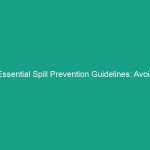Introduction
In the realm of industrial operations, health, safety, and Environment (HSE) play a pivotal role in ensuring the well-being of workers and the surrounding community. Among various industrial tasks, Safety in Tank Cleaning and Gas-Freeing Operations stands out due to the inherent risks involved. Tank cleaning and gas-freeing operations are essential for maintaining equipment and ensuring Environmental Safety, yet they pose significant challenges if not executed correctly. This article aims to explore the critical aspects of HSE in these operations, emphasizing the importance of Safety protocols, regulatory frameworks, best practices, and real-world case studies to illustrate the potential pitfalls and necessary Precautions.
Understanding the Risks in Tank Cleaning and Gas-Freeing Operations
Tank cleaning and gas-freeing operations are often performed in confined spaces, which can lead to various Hazards such as exposure to toxic substances, fire, and explosion risks. Understanding these risks is the first step toward implementing effective Safety Measures.
Identifying Common Hazards
Common hazards associated with tank cleaning and gas-freeing operations include:
- Toxic Atmospheres: Tanks often contain residual chemicals or vapors that can be harmful if inhaled.
- Flammable Materials: The presence of flammable vapors can lead to Fires or explosions.
- Confined Spaces: Working in confined spaces increases the risk of accidents and makes rescue operations difficult.
- Noise Exposure: High noise levels from cleaning equipment can lead to hearing loss over time.
Consequences of Neglecting Safety
Neglecting safety in tank cleaning and gas-freeing operations can lead to severe consequences, including injuries, fatalities, and legal ramifications. Additionally, incidents can result in environmental damage, negatively impacting the company’s reputation and leading to significant financial losses. Implementing effective Safety Measures is not just a regulatory requirement; it is essential for protecting employees and the environment.
Regulatory Frameworks Governing Safety in Tank Cleaning and Gas-Freeing Operations
Several regulatory bodies oversee safety practices in tank cleaning and gas-freeing operations. Understanding these frameworks is crucial for compliance and ensuring safety.
Key Regulatory Standards
Among the prominent Regulations are:
- OSHA Standards: The Occupational Safety and Health Administration (osha) sets forth regulations to ensure Workplace Safety, particularly concerning confined spaces and hazardous materials.
- EPA Regulations: The Environmental Protection Agency (EPA) regulates environmental safety, ensuring that companies adhere to environmental standards during cleaning and gas-freeing operations.
- ANSI Standards: The American National Standards Institute (ANSI) provides guidelines for safety practices, including those related to confined spaces and hazardous materials.
Compliance and Best Practices
Compliance with these regulations requires companies to implement Best Practices that not only meet legal requirements but also foster a culture of safety. Regular Training sessions, safety audits, and risk assessments are crucial components of effective compliance strategies.
Best Practices for Safety in Tank Cleaning and Gas-Freeing Operations
Implementing best practices is key to mitigating risks associated with tank cleaning and gas-freeing operations. Here are several recommendations that can significantly enhance safety.
Comprehensive Training Programs
All personnel involved in tank cleaning and gas-freeing operations should undergo comprehensive training. This training should cover:
- Understanding the hazards associated with tank cleaning.
- Proper use of Personal Protective Equipment (PPE).
- Emergency response protocols.
- Safe work practices and Procedures.
Personal Protective Equipment (PPE)
The use of appropriate PPE is vital in protecting workers from hazardous substances. Essential PPE for tank cleaning includes:
- Respirators for protection against toxic vapors.
- Protective clothing to prevent skin contact with hazardous materials.
- Gloves and goggles to safeguard against splashes and spills.
Effective Ventilation Systems
Proper ventilation is crucial in confined spaces to ensure that harmful vapors are diluted and removed. Implementing effective ventilation systems can significantly reduce the risk of exposure to toxic atmospheres.
Regular Safety Audits
Conducting regular safety audits helps identify potential risks and areas for improvement. These audits should assess:
- Compliance with safety regulations.
- Effectiveness of safety training programs.
- Condition and Maintenance of safety equipment.
Emergency Preparedness and Response
Having a robust emergency response plan is critical. This plan should include procedures for evacuating personnel, notifying emergency services, and conducting rescue operations in case of an incident. Regular drills should be conducted to ensure that all personnel are familiar with the emergency protocols.
Case Studies: Learning from Real-World Incidents
Examining real-world case studies provides valuable insights into the importance of safety in tank cleaning and gas-freeing operations. These examples highlight the potential consequences of neglecting safety protocols and the effectiveness of proper safety measures.
Case Study 1: The Explosion Incident
A major oil company faced a catastrophic explosion during a tank cleaning Operation due to the accumulation of flammable vapors. The incident resulted in significant injuries and extensive damage. Investigations revealed that inadequate ventilation and a lack of proper training were primary contributors to the accident. Following the incident, the company revamped its safety protocols, emphasizing training and ventilation improvements.
Case Study 2: Toxic Exposure
In another incident, workers were exposed to toxic fumes during a gas-freeing operation due to inadequate monitoring of air quality. This case underscored the necessity of continuous monitoring and the implementation of safety measures, such as gas detection systems, to prevent similar occurrences in the future. The company adopted a more rigorous approach to air quality monitoring and enhanced employee training to address these risks.
Challenges in Ensuring Safety in Tank Cleaning and Gas-Freeing Operations
Despite the well-defined regulations and best practices, various challenges persist in ensuring safety in tank cleaning and gas-freeing operations.
Human Factors
Human error remains a significant challenge in maintaining safety. Factors such as fatigue, lack of attention, and insufficient training can lead to mistakes that compromise safety. Companies must foster a safety culture that encourages vigilance and accountability among workers.
Technological Limitations
While technology plays a crucial role in enhancing safety, limitations exist. For instance, gas detection systems may malfunction or fail to detect certain hazardous substances. Therefore, relying solely on technology without adequate human oversight can pose risks. Regular maintenance and testing of equipment are essential to mitigate these limitations.
Regulatory Compliance Costs
Compliance with safety regulations can be costly, particularly for smaller companies. The financial burden of implementing safety measures may discourage some businesses from prioritizing HSE. However, investing in safety not only protects employees but also enhances overall operational efficiency and reduces long-term costs associated with accidents.
Future Trends in Safety Practices for Tank Cleaning and Gas-Freeing Operations
As industries evolve, so do safety practices. Several trends are emerging that are likely to shape the future of safety in tank cleaning and gas-freeing operations.
Increased Automation
The use of automation in tank cleaning processes is on the rise. Automated cleaning systems can reduce human exposure to hazardous environments and improve efficiency. However, the integration of automation must be accompanied by adequate training and safety measures to ensure system reliability.
Enhanced Monitoring Technologies
Advancements in monitoring technologies, such as real-time gas detection and environmental monitoring systems, are improving safety outcomes. These technologies provide immediate feedback, allowing for swift action in response to hazardous conditions.
Focus on Mental Health and Well-being
Recognizing the importance of mental health in Workplace Safety is gaining traction. Companies are implementing programs to address mental well-being, ensuring that workers are not just physically safe but also mentally prepared to perform their duties effectively.
Conclusion
Ensuring Safety in Tank Cleaning and Gas-Freeing Operations is paramount for protecting workers and the environment. By understanding the risks, adhering to regulatory frameworks, implementing best practices, and learning from past incidents, companies can create safer work environments. The challenges faced in these operations require ongoing commitment and attention, but the Benefits of prioritizing safety far outweigh the costs. As we look to the future, embracing technological advancements and fostering a culture of safety will enhance our ability to mitigate risks. Let us commit to making safety a priority in every aspect of tank cleaning and gas-freeing operations. Together, we can build a safer industry for everyone involved.


